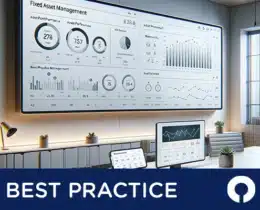Why use Web-Based Asset Tracking?
What are the benefits of using cloud-based software for asset tracking? We discuss the ways that web-based asset tracking software can benefit your business.
What are the benefits of using cloud-based software for asset tracking? We discuss the ways that web-based asset tracking software can benefit your business.
Accurately tracking the location, status, depreciation, and maintenance of assets is essential for asset-heavy businesses. Web-based asset tracking software allows you to stay in control of all assets across the business, making it easy to gain visibility, manage maintenance, and save time and money with a more efficient asset management process.
But how does web-based asset tracking work, and what are the benefits of using online software for tracking assets? Let’s explore the specifics and discuss how web-based asset tracking software compares to alternatives.
In the past, asset tracking used to be carried out using handwritten ledgers, and today some organisations still use manually created spreadsheets for their database. With all the information manually added and updated, there’s a high risk of human error. All it takes is a smudged number or a mistyped word to send your asset register into chaos. Traditional asset tracking methods often result in lost assets or assets that have not received the necessary maintenance. Consequently, these assets need to be replaced frequently, even though proper maintenance and tracking could extend their lifespans. This is an expensive and inefficient system; often, businesses are not even aware of how much money they are throwing away each year due to this inefficiency.
The key feature of web-based asset tracking software is that it allows users to access and update the asset register from anywhere using a desktop or mobile device. Streamlining asset management and equipment tracking, this software boosts visibility over assets, improves maintenance and asset lifespans, and brings greater efficiency to all aspects of asset management.
Online asset tracking software often works using smartphones or other barcode scanners. Users can simply scan the barcode to update the asset database in real time, minimising the risk of human error during data entry. This makes it easy to update the database with information about assets from the field.
Cloud-based software allows you to store all your database on the provider’s servers. Your organisation does not need to provide any on-site servers or operating systems to use the software, all of this is held by the vendor. All your organisation needs to do is use the web or mobile app to access and update the database.
Online asset tracking software is usually priced as a subscription model, with the organisation paying an annual or monthly licence to the vendor. This means that there is no expensive up-front investment. Moreover, there’s no need for complicated server installations, making it easy to get started quickly.

Cloud-based asset tracking software allows you to access and update information from anywhere in the world as long as you have an internet connection. Your web-based asset management software eliminates all guesswork, allowing users to instantly access all the information they need about the location, maintenance history, and condition of assets. Web-based tracking makes it possible to effortlessly track assets across different locations, companies, and countries, with granular location tracking down to shelf and bin level.

With the database stored securely in the cloud, it is protected from any problems that might arise on-site such as power outages or server failures. No matter what happens, you have access to information about all physical assets stored safely online. You can easily check a supplier’s credentials by asking about certification for standards such as ISO 27001.

To carry out audits, all you need to do is use a mobile device with a barcode or RFID scanner. Without laborious and error-prone manual data entry, audits can be carried out quickly and accurately to keep the database up to date.

Web-based asset tracking solutions improve the accuracy of reporting with up-to-date detailed information generated instantaneously. By applying the different report templates, it’s easy to create customised reporting for management, finance, or operations users. With accurate and up-to-date reporting, organisations can take greater control of their assets and increase the efficiency of operations.

Web-based asset tracking makes it easy to record and track all the asset events from an item’s purchase to disposal, including check-in/check-out, maintenance, and user assignments. Online asset tracking databases also allow you to attach key documents and notes such as purchase orders or warranty documents for better control over assets throughout their lifecycle.

With a cloud-based system, it’s easy to scale your database and functions in accordance with your needs. In the case of equipment checkout, deployment, reporting, and barcode tagging, some of the asset activities that are most prone to errors, web-based software can ensure accuracy as the operations scale up.

With software that is based in the cloud, your organisation has easy access to any updates and upgrades created by the vendor. This might include improvements to the content of the software or essential security updates for organisations with growing databases. Because of the flexibility of cloud-based software, this is a great long-term solution for tracking assets.

Using a web-based asset tracker can streamline and optimise your operations. By improving visibility and maintenance scheduling (or work orders), online asset tracking means that you can reduce equipment downtime and write-offs. Easy-to-access software for asset tracking also reduces the risk of assets going missing or being stolen. Finally, using a specialist asset management tool allows businesses to enjoy lower insurance premiums, saving additional money through the use of the software.

Organisations that choose to use an on-premises solution for asset management need a dedicated IT team to install, operate, update, and troubleshoot the system whenever necessary. In contrast, organisations that use a cloud-based tool to manage their assets have no need for these additional staff and expenses because their vendor will provide these services.
Any organisation with a lot of assets to keep track of needs a powerful asset tracking solution to streamline and enhance operations. It doesn’t matter whether your business is in manufacturing, oil and gas, health, education, or another industry — a web-based asset management software is essential to get the best use out of your assets.
Looking for your perfect cloud-based asset tracking tool? FMIS asset tracking allows you to take complete control of your assets, inventory, and equipment using customisable and powerful software. Making it easier to view and update the location, condition, and history of all assets across multiple locations, including vendors and service providers, FMIS software enhances your asset management capabilities.
Using standard or user-defined fields, different departments can access the specific asset data they require for operations, financial, and IT needs. It is also accessible on a range of devices, providing a flexible solution to all your asset management needs.
For more information on how FMIS can help you effectively track and manage your assets and equipment, please get in touch with an FMIS consultant or call us on +44 (0) 1227 773003.
 /wp-content/uploads/2024/10/Optimising-Fixed-Asset-Lifecycles-495x400-1.webp400495John de Robeck/wp-content/uploads/2016/07/FMIS-logo-340x156.pngJohn de Robeck2024-10-25 13:08:502024-10-25 13:08:52Optimising Fixed Asset Lifecycles: From Acquisition to Disposal
/wp-content/uploads/2024/10/Optimising-Fixed-Asset-Lifecycles-495x400-1.webp400495John de Robeck/wp-content/uploads/2016/07/FMIS-logo-340x156.pngJohn de Robeck2024-10-25 13:08:502024-10-25 13:08:52Optimising Fixed Asset Lifecycles: From Acquisition to Disposal

FMIS Ltd
167b John Wilson Business Park
Whitstable
Kent
CT5 3RA
United Kingdom
Phone:+44 (0) 1227 773003
Fax:+44 (0) 1227 773005
Sales:sales@fmis.co.uk
Support:support@fmis.co.uk

 What are the Stages of Asset Lifecycle Management?
What are the Stages of Asset Lifecycle Management?| Cookie | Duration | Description |
|---|---|---|
| cookielawinfo-checkbox-advertisement | 1 year | Set by the GDPR Cookie Consent plugin, this cookie is used to record the user consent for the cookies in the "Advertisement" category . |
| cookielawinfo-checkbox-analytics | 11 months | This cookie is set by GDPR Cookie Consent plugin. The cookie is used to store the user consent for the cookies in the category "Analytics". |
| cookielawinfo-checkbox-functional | 11 months | The cookie is set by GDPR cookie consent to record the user consent for the cookies in the category "Functional". |
| cookielawinfo-checkbox-necessary | 11 months | This cookie is set by GDPR Cookie Consent plugin. The cookies is used to store the user consent for the cookies in the category "Necessary". |
| cookielawinfo-checkbox-others | 11 months | This cookie is set by GDPR Cookie Consent plugin. The cookie is used to store the user consent for the cookies in the category "Other. |
| cookielawinfo-checkbox-performance | 11 months | This cookie is set by GDPR Cookie Consent plugin. The cookie is used to store the user consent for the cookies in the category "Performance". |
| CookieLawInfoConsent | 1 year | Records the default button state of the corresponding category & the status of CCPA. It works only in coordination with the primary cookie. |
| PHPSESSID | session | This cookie is native to PHP applications. The cookie is used to store and identify a users' unique session ID for the purpose of managing user session on the website. The cookie is a session cookies and is deleted when all the browser windows are closed. |
| viewed_cookie_policy | 11 months | The cookie is set by the GDPR Cookie Consent plugin and is used to store whether or not user has consented to the use of cookies. It does not store any personal data. |
| Cookie | Duration | Description |
|---|---|---|
| CONSENT | 2 years | YouTube sets this cookie via embedded youtube-videos and registers anonymous statistical data. |
| _ga | 2 years | The _ga cookie, installed by Google Analytics, calculates visitor, session and campaign data and also keeps track of site usage for the site's analytics report. The cookie stores information anonymously and assigns a randomly generated number to recognize unique visitors. |
| _gat_UA-48954022-1 | 1 minute | A variation of the _gat cookie set by Google Analytics and Google Tag Manager to allow website owners to track visitor behaviour and measure site performance. The pattern element in the name contains the unique identity number of the account or website it relates to. |
| _gid | 1 day | Installed by Google Analytics, _gid cookie stores information on how visitors use a website, while also creating an analytics report of the website's performance. Some of the data that are collected include the number of visitors, their source, and the pages they visit anonymously. |
| Cookie | Duration | Description |
|---|---|---|
| VISITOR_INFO1_LIVE | 5 months 27 days | A cookie set by YouTube to measure bandwidth that determines whether the user gets the new or old player interface. |
| YSC | session | YSC cookie is set by Youtube and is used to track the views of embedded videos on Youtube pages. |
| yt-remote-connected-devices | never | YouTube sets this cookie to store the video preferences of the user using embedded YouTube video. |
| yt-remote-device-id | never | YouTube sets this cookie to store the video preferences of the user using embedded YouTube video. |
